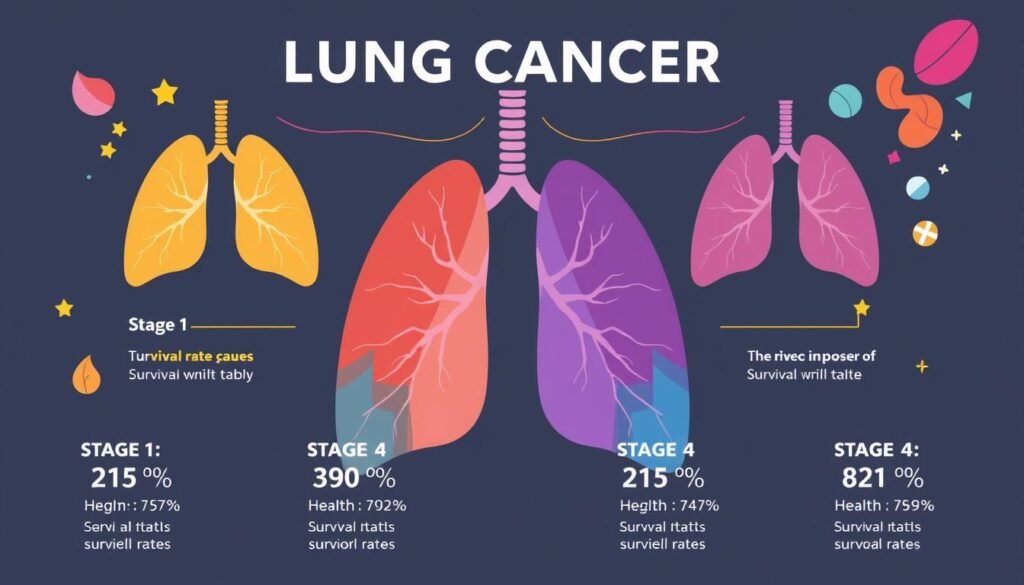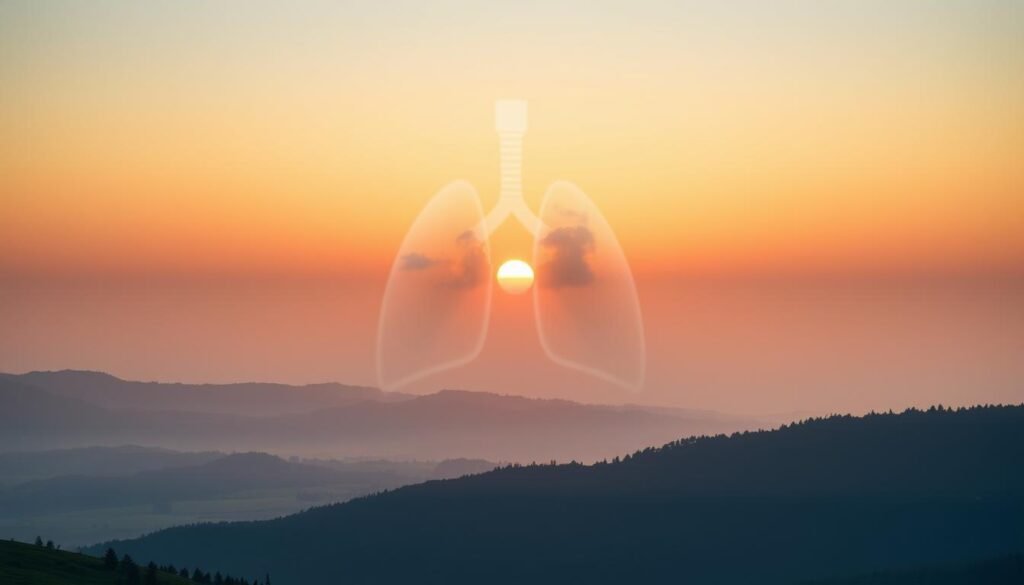Did you know the five-year survival rate for lung cancer is about 25.4 percent? This figure shows how lung cancer’s stage and type critically affect life expectancy. It’s vital for patients, caregivers, and healthcare pros to grasp this. It helps set realistic survival odds and guides toward treatment choices that might better life quality.
The type and stage at diagnosis heavily shape lung cancer’s prognosis. Localized cancers have much better survival odds, around 62.8 percent. But, survival rates for distant stage cancers drop to near 8 percent. These numbers underline the need for prompt, effective treatment and understanding survival rate differences across lung cancer types.
In this article, we delve into lung cancer types, like Non-Small Cell Lung Cancer (NSCLC) and Small Cell Lung Cancer (SCLC). We’ll see how crucial staging is for patient survival. For deeper stats, check out lung cancer survival rates for real-world insights.
Key Takeaways
- The average five-year relative survival rate for lung cancer is about 25.4%.
- Localized lung cancer has a five-year survival rate of approximately 62.8%.
- Distant lung cancer drastically drops to a survival rate of around 8%.
- The subgroup of cancer types shows varying five-year survival rates; for instance, NSCLC has a rate of 22.8% while SCLC is only about 8.6%.
- Understanding the stage and type of lung cancer is essential for evaluating prognosis and treatment options.
- Timely diagnosis and treatment can improve survival chances significantly.
Introduction to Lung Cancer
Lung cancer leads in cancer deaths in the United States. Gaining lung cancer awareness is key. About 234,580 new cases are expected in 2024. This underlines the need for early detection.
Knowing the early signs of lung cancer is crucial for saving lives. Signs include a constant cough, breathlessness, and losing weight without trying. Most people diagnosed are around 70, especially those over 65. Lung cancer affects people differently, with Black men at higher risk than White men.
Research keeps improving our understanding of lung cancer. Efforts to raise awareness encourage early doctor visits and screenings. These steps are vital for better survival rates. Lung cancer causes about one in five cancer deaths in the U.S. Focusing on awareness and early action can really make a difference.
| Statistic | Value |
|---|---|
| Estimated new cases in 2024 | 234,580 |
| Expected deaths in 2024 | 125,070 |
| Lifetime risk for men | 1 in 16 |
| Lifetime risk for women | 1 in 17 |
| Percentage of lung cancers that are NSCLC | 80% to 85% |
| Percentage of lung cancers that are SCLC | 10% to 15% |
Understanding Lung Cancer Types
Lung cancer comes in different types. It’s mainly split into Non-Small Cell Lung Cancer (NSCLC) and Small Cell Lung Cancer (SCLC). Knowing the type is crucial for figuring out the best treatment and predicting outcomes.
Non-Small Cell Lung Cancer (NSCLC)
About 85-90% of lung cancer cases are NSCLC. This kind often has a better chance of recovery than SCLC. How well people with NSCLC do depends a lot on how early the cancer is found:
| Stage | 5-Year Survival Rate |
|---|---|
| Localized (Stage 1) | 65% |
| Regional (Stage 2) | 40% |
| Distant (Stage 3) | 15% |
People with NSCLC found early, in the localized stage, tend to do much better. Finding it early and starting treatment right away help a lot.
Small Cell Lung Cancer (SCLC)
SCLC makes up about 10-15% of lung cancers. It grows quickly and is often found after it has spread. SCLC has lower survival rates than NSCLC:
| Stage | 5-Year Survival Rate |
|---|---|
| Localized | 29% |
| Regional | 15% |
| Distant | 3% |
SCLC found when it’s still limited has a better outlook than when it’s widespread. Patients and doctors use this info to choose the best treatment path.
Lung Cancer Staging Explained
Lung cancer staging is key in choosing treatment and predicting outcomes. It looks at three things: tumor size, lymph node involvement, and metastasis presence. Knowing these helps describe each cancer stage precisely.
Stage I means the cancer hasn’t moved, which gives patients a strong survival chance. Stage II shows cancer has reached lymph nodes, indicating a deeper issue. In stage III, tumors spread to more chest areas and more lymph nodes. Stage IV is where cancer reaches other body parts, complicating treatment efforts.
Survival rate statistics are a wake-up call. The overall 5-year rate for lung cancer is just 16%. But, it jumps to nearly 50% if caught early. Sadly, more than half of patients might die within a year without treatment. This shows why correct staging is crucial.
Lung cancer staging uses exams, imaging, and biopsies to find the cancer’s stage. This helps doctors create the best treatment plan, greatly affecting a patient’s future. Understanding the TNM system is vital for anyone dealing with lung cancer.
Stage and Type of Lung Cancer Impact on Life Expectancy
The stage and type of lung cancer are key in determining how long a patient might live. Knowing how these factors come together helps us understand their prognosis better. Early-stage lung cancer usually means a better chance of survival compared to late-stage diagnoses.
Survival Rates by Stage
Survival rates for lung cancer vary a lot depending on the stage. About 65% of those with stage I lung cancer live five years after finding out they have it. If lung cancer is found at stage IV, only about 5% can expect to live that long. Sadly, too many patients find out they have lung cancer when it’s already advanced—about 67.6% in the UK and 79% in the USA are diagnosed at stage III or IV. This highlights how crucial early detection is for improving survival chances.
The Role of Cancer Type in Life Expectancy
What type of lung cancer someone has also affects how long they might live. Non-small cell lung cancer (NSCLC) makes up about 85% of all lung cancer cases, while small cell lung cancer (SCLC) is about 10-15%. For people with early-stage SCLC, the five-year survival rate is around 27%. But if SCLC is found later, at an extensive stage, survival drops to just 3%. NSCLC patients generally have a better outlook than those with SCLC. However, even with treatment improvements, many patients do not live beyond five years after their diagnosis.

Factors Affecting Lung Cancer Survival Rates
It’s vital to know what affects lung cancer survival rates for patients and their families. Many factors can change the outlook of the disease. A patient’s overall health can influence how they handle treatment and recovery. Things like fitness level, age, and other health conditions are key in determining outcomes.
When looking at lung cancer survival, it’s critical to focus on certain elements. Genetic mutations can change how well treatments work. Getting tested for these mutations lets doctors customize treatment. This can improve survival chances. For instance, NSCLC patients with specific mutations may live longer with targeted treatments.
- Age: Younger patients often respond better to treatment.
- Overall Health: Strong health can boost recovery and chances of survival.
- Genetic Factors: Knowing about mutations can guide treatment choices.
- Response to Treatment: People react differently to treatments like chemotherapy or surgery.
By focusing on these factors, better treatment decisions can be made. Tailoring care to these elements can bring hope. With the right medical approaches, improving survival rates is possible.
Early-Stage Lung Cancer Life Expectancy
Early-stage lung cancer has encouraging survival rates for those found in the first stages. Over 65% of people with stage I lung cancer survive five years or more after being diagnosed. This fact highlights how crucial early detection and treatment are. The survival statistics for stages I & II show the power of catching the disease early. For example, stage IA1 patients have an amazing 92% chance of surviving five years. Meanwhile, stages IA2 and IB see survival rates of 83% and 68%, respectively.
Stage I lung cancer is a critical time for treatment. That’s because the cancer hasn’t spread to the lymph nodes yet. At this point, most patients have a high chance of being cured. The cure rate for these early tumors is between 80%-90%.
Finding cancer early is key to beating it. Regular check-ups are important, especially for those at high risk. There are many ways to treat early-stage lung cancer. These include surgery, chemotherapy, radiation, and newer methods like stereotactic ablative body radiation therapy. Choosing the right treatment for each person makes beating cancer more likely.
Dealing with lung cancer emotionally is just as important as treating it physically. Support groups can be very helpful. They offer a place for patients and their loved ones to find understanding and ways to cope.

| Stage | Survival Rate (5-Year) | Cure Rate |
|---|---|---|
| IA1 | 92% | 80%-90% |
| IA2 | 83% | 80%-90% |
| IB | 68% | 80%-90% |
Advanced Lung Cancer Life Expectancy
People with stage IV lung cancer face tough challenges. This stage means the cancer has spread to other body parts. The advanced lung cancer life expectancy at this stage is quite low. This is due to the complex treatments needed and the patient’s health.
For those with stage IV non-small cell lung cancer (NSCLC), the five-year survival rate is just 9%.
Understanding Stage IV Lung Cancer Prognosis
The outlook for stage IV lung cancer depends on several things. It changes based on where the cancer has spread and the patient’s health. Some live about 11.4 months while others might only have 6.3 months.
After getting diagnosed with stage IV lung cancer, only 15% to 19% live past one year. Long-term survival is rare. Older people and those with high tumor markers often have worse outcomes.
For example, the survival rate for men with stage IV NSCLC is roughly 5.6%. For women, it’s about 8.6%. Things like how active the patient can be also count. Some with better health have a five-year survival rate of 45.9% compared to 18.7% for others.
It’s crucial to tailor treatment plans for those with advanced lung cancer. Knowing about treatment options can help increase long-term survival rates.
| Survival Rate Type | Five-Year Survival Rate |
|---|---|
| Stage IV NSCLC (Overall) | 9% |
| Stage IV NSCLC (Men) | 5.6% |
| Stage IV NSCLC (Women) | 8.6% |
| M1a Median Survival | 11.4 months |
| M1c Median Survival | 6.3 months |
Lung Cancer Treatment Options
When it comes to battling lung cancer, various treatment options exist. Each method plays a significant role in patient outcomes. We have surgery, chemotherapy, radiation therapy, and new targeted therapies available.
Surgery is the first defense for patients with early-stage non-small cell lung cancer (NSCLC). It involves removing tumors and nearby tissue. For stages I, II, and IIIA, this can greatly increase survival chances. On the other hand, chemotherapy is common for advanced stages like stage IV NSCLC. It’s a first-line therapy and offers a median survival of about 8-10 months.
For patients who can’t have surgery, radiation therapy is crucial. It helps those with localized NSCLC. New techniques in radiation have improved the treatment’s effectiveness significantly.
Targeted therapies are a leap forward in personalized cancer treatment. They focus on the genetic changes in some lung cancers. For patients with certain genetic markers, these treatments can lead to better outcomes.
Clinical trials are always testing new treatments for lung cancer. These include new drug combinations, immunotherapies, and precision medicine advances. Research brings hope for better treatment options in the future. Staying informed about medical advances is vital.
| Treatment Method | Best For | Typical Outcomes |
|---|---|---|
| Surgery | Early-stage NSCLC (stages I, II, IIIA) | Improved survival rates |
| Chemotherapy | Advanced-stage NSCLC (stage IV) | Median survival 8-10 months |
| Radiation Therapy | Localized tumors in non-surgical patients | Symptom relief and potential delay in cancer progression |
| Targeted Therapies | Patients with specific genetic changes | More favorable treatment response rates |
Lung Cancer Risk Factors
Lung cancer is a major health issue worldwide. Knowing the lung cancer risk factors is key for prevention. These factors include genetic traits and lifestyle choices. They show us why some people are more likely to get lung cancer.
Genetic Factors and Their Impact
Genes play a big role in lung cancer risk. If lung cancer runs in your family, you might be at higher risk. This is due to genetic changes that make you more sensitive to environmental hazards.
Lifestyle choices also influence lung cancer risk. Smoking is the biggest risk factor. The more you smoke, the greater your risk. Being around radon gas and substances like asbestos also raises your risk. Knowing about these factors can lead to better health decisions.
Quitting smoking and eating healthy can lower your lung cancer risk. While prevention isn’t always certain, understanding genetic and lifestyle factors is helpful. These choices can lead to better health.
| Risk Factor | Description | Impact on Lung Cancer Risk |
|---|---|---|
| Smoking | Inhalation of tobacco smoke | Significantly increases risk; stronger correlation with higher daily cigarette use |
| Genetic Predisposition | Family history of lung cancer | Elevated risk due to inherited mutations |
| Environmental Exposure | Radon gas, asbestos, and other carcinogens | Increases risk, especially when combined with smoking |
| Age | Older age, particularly over 55 | Risk increases as age advances |
| Gender | Men generally have a higher incidence | Higher prevalence in male populations |
If you want to learn more about lung cancer types and how they’re diagnosed, check out the details here.
Latest Insights and Research on Lung Cancer
The fight against lung cancer is seeing exciting progress thanks to recent research. New treatments offer hope for those affected. Innovative approaches focus on better patient care and outcomes. Targeted therapies are now zeroing in on specific genetic changes, such as RAS proteins.
These advancements aim to increase survival and improve patients’ lives. It’s a promising time for those battling lung cancer.
Research also highlights how air pollution impacts lung cancer, especially EGFR-positive types. It’s vital to understand how the environment affects lung cancer risk. Sadly, stage IV patients have a low survival rate, with about 5% living five years or more.
Despite high early mortality rates, advances in treatment are improving future outlooks. These breakthroughs inform therapy choices and boost survival chances.

The research community is also improving radiotherapy. Studies like the CONVERT trial show that certain combined treatments can be effective. This balances treatment success with patient comfort.
Support systems are crucial for those undergoing treatment. They provide medical and emotional support. This helps with recovery and managing the disease.
To conclude, personalized treatments from ongoing research offer new hope to lung cancer patients. Better therapies and disease understanding are changing lives. It’s a greener pasture for those touched by lung cancer.
Conclusion
Lung cancer’s journey shows how the disease type and stage affect patient life expectancy. Knowing about life expectancy is key for patients and families as they look into treatments and support. The survival rates differ greatly, like the 5-year survival rate of 9% for SCLC against 28% for NSCLC, showing why early help and custom treatments matter.
About 53% of lung cancers have spread by the time they’re found. This stresses the need for early screening in those at high risk. Giving full support can greatly improve life quality during and after treatment. This shows how crucial support is for both patients and caregivers who face the emotional impact of the diagnosis.
With advances in research and treatments, understanding these stats is vital. Yet, it’s crucial to remember each case is different. Fighting for early detection and talking openly with doctors helps patients make wise choices on their journey. For deeper insights on lung cancer outcomes, check this comprehensive resource.